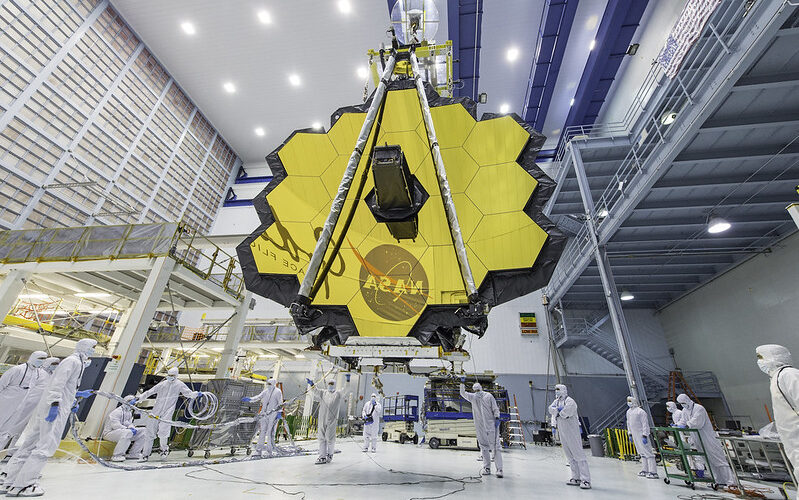What is the James Webb Space Telescope?
The James Webb Space Telescope was created to replace the Hubble Space Telescope, which was launched into space in 1990 to study the universe and solve mysteries about the universe. The JWST is the largest human-made space telescope that has overcome the limitations of the Hubble Space Telescope. The JWST was jointly invested in and developed by NASA, the Canadian Space Agency, and the European Space Agency in 1996. It was launched on December 25, 2021, to carry out its mission. Its function is about 100 times better than that of the Hubble Space Telescope and about 10 billion times better than human vision. It is named after James Webb, one of the earliest managers of the National Aeronautics and Space Administration (May, 2022).
Where is the James Webb Space Telescope in space?
The JWST was launched from Earth on Christmas Day of 2021 and arrived at its final destination, L2, on January 24, 2022, after about a month of flight. Point L2 means Lagrange 2. Lagrange Point refers to the positions where a third small object can maintain its position under the influence of the gravity of two large objects in space. In other words, due to the influence of the Sun’s and Earth’s gravity, an object at the Lagrange point can maintain the same distance from Earth continuously without leaving its place. There are five Lagrange Points total. These sites are named after Joseph Louis Lagrange, who discovered them in the 18th century. Located at the L2 point, the JWST maintains the same distance from Earth, and always sees the Sun and Earth in the same direction while orbiting the Sun. The site is about 1.5 million kilometers away from Earth. It is nearly four times the distance between the Earth and the moon. While the Hubble Space Telescope carried out its mission 570 kilometers above Earth, the JWST performs its duties much farther away from Earth.
What is the mission of the James Webb Space Telescope?
The JWST was created with the international cooperation of several space agencies. For this reason, there are various tasks it has to perform for those space agencies. The followings are representative missions:
- Very distant space observation – The JWST has the ability to see further than any other space telescope ever built.
- Investigation of the first light in the universe – Many scientists argue that right after the Big Bang, the birth of the universe, the universe was a space of countless particles, and that light did not exist until the temperature of the universe cooled and the particles joined together. The JWST will serve to gather information on this claim.
- Extensive research on galaxies and stars – The JWST has a mission to find the first star and galaxy created after the Big Bang. In other words, it refers to examining traces of the early universe. Examining galaxies allows us to find out information on the materials that make up the galaxy. Such information can be factors that can solve the question of how the universe has evolved. In fact, spiral and elliptical galaxies have evolved into different shapes for billions of years. Examining early galaxies in the universe helps us better understand the evolution of these galaxies.
- Exploring Extraterrestrial Life – Scientists and astronomers have already selected several planets that may have life with different space telescopes. There are countless stars like the Sun in space. Many astronomers have argued that there are planets near stars that have a suitable environment for life, such as Earth. The JWST’s enhanced capability over conventional space telescopes will allow us to scrutinize the atmospheres of distant planets. These factors will play an important role in making it possible for scientists to predict whether life can live on a particular planet.
Conclusion
NASA expects the James Webb Space Telescope to last as long as five years. But they hope the JWST will operate for more than a decade. Equipped with state-of-the-art technology and efficient features, the space telescope is carrying out its mission by settling at L2 Point. Information on the universe from the JWST is likely to have a significant impact on future of space activities.
References
May, A. (2022). James Webb Space Telescope: Origins, design and mission objectives. [online] livescience.com. Available at: https://www.livescience.com/james-webb-space-telescope [Accessed 7 August 2022].
Hughes, A. (2022). When will the James Webb Space Telescope launch? All you need to know about Hubble’s successor. [online] BBC Science Focus Magazine. Available at: https://www.sciencefocus.com/space/james-webb-space-telescope/ [Accessed 6 August 2022].
Howell, E. and Dobrijevic, D. (2022). NASA’s James Webb Space Telescope: Hubble’s Cosmic Successor. [online] Space.com. Available at: https://www.space.com/21925-james-webb-space-telescope-jwst.html#section-james-webb-space-telescope-launch-and-deployment [Accessed 9 August 2022].
Space com Staff (2022). NASA’s James Webb Space Telescope mission: Live updates. [online] Space.com. Available at: https://www.space.com/news/live/james-webb-space-telescope-updates [Accessed 8 August 2022].
Feature Image https://www.flickr.com/photos/nasawebbtelescope/33433274343/in/album-72157711864921848/
